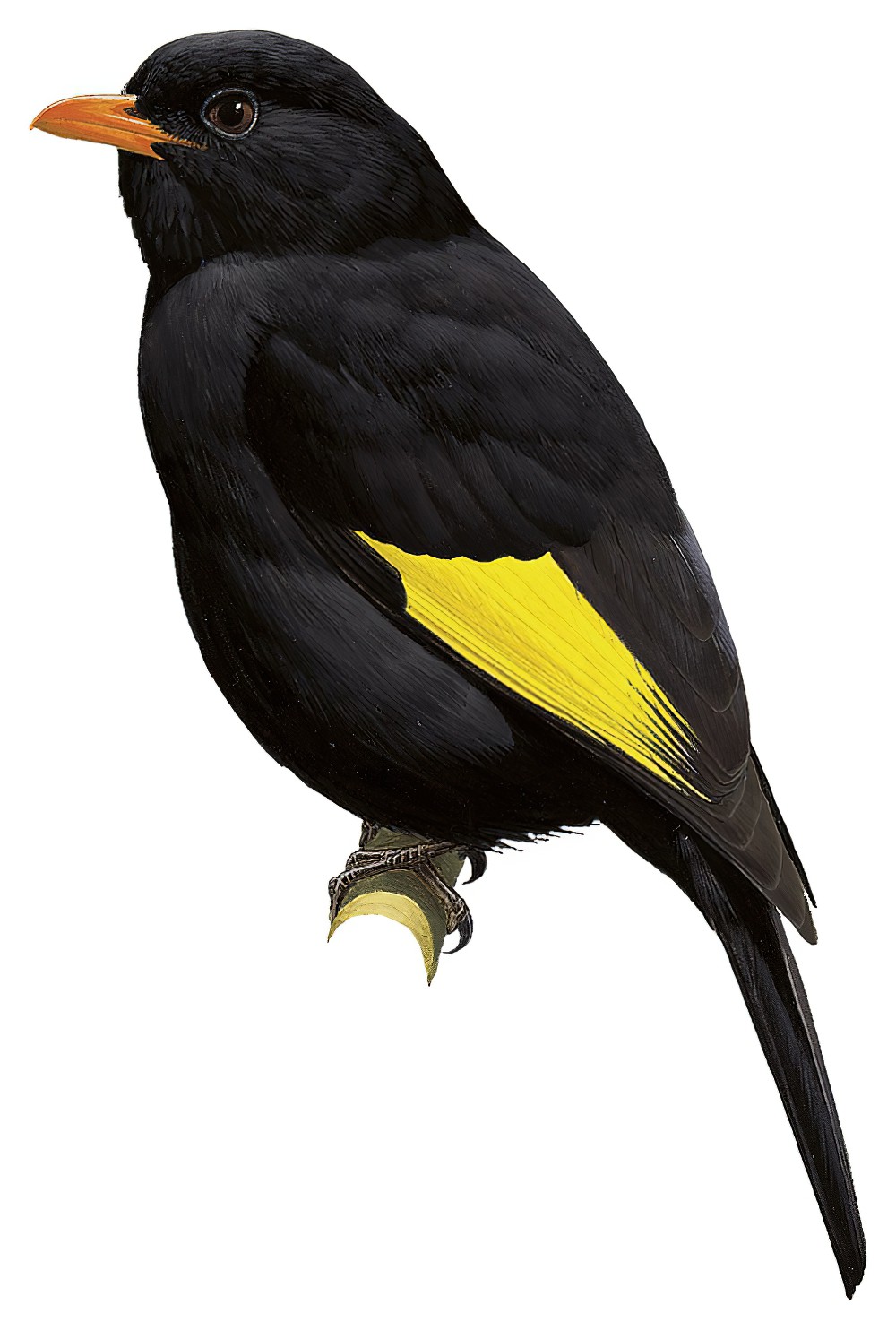Black-and-gold Cotinga / Tijuca atra

Black-and-gold Cotinga
SCI Name:
Protonym: Tijuca atra Bull.Sci.Nat.[Ferussac] 19 p.324
Taxonomy: Passeriformes / Cotingidae / Tijuca
Taxonomy Code: bagcot1
Type Locality: interior of Brazil; restricted to Serra do Mar, Rio de Janeiro, by Pinto, 1944, Cat. Aves Brasil (Publ. Dept. Zool., Sao Paulo), pt. 2, p. 6.
Author: Férussac
Publish Year: 1829
IUCN Status: Least Concern
DEFINITIONS
Tijuca
(syn. Lipaugus Ϯ Black-and-gold Cotinga L. ater) Marcgrave 1648, gave Tijeguacú as a Tupí name for a type of manakin or cotinga, and de Buffon 1770-1783, wrote that Tijé is a Tupí generic term (Tupí Tié finch, used in combination for various tanagers) and used “Tijé” for the Blue-backed Manakin. “Derivations of Indian names, as this is, are often uncertain. There are two possibilities: (1) tî = bill, yúb = yellow ... etymologically doubtful [but Tijú is so listed by Garcia 1929]; (2) tijuca = swamp, a word used in some Brazilian place names but not apt for a bird of montane forest” (Snow 1982); "TIJUCA NOIR, Tijuca atra, Lesson. Genre nouveau d'oiseau dont l'espèce type est de la taille d'un merle auquel elle ressemble beaucoup par son facies et son plumage noir profond. Le Tijuca a les ailes noires et un large miroir d'un beau jaune sur leur partie moyenne; le bec et les tarses jaunes. Son bec fortement denté le rapproche des pie-grièches; sa base et ses commissures lui donnent quelqu'analogie avec les chocards. Le Tijuca noir vient de l'intérieur du Brésil." (de Férussac 1829); "Tijuca Férussac, 1829, Bull. Sci. Nat., 19, p. 324. Type, by monotypy, Tijuca atra Lesson [= Férussac]." (Snow in Peters 1979, VIII, 284). Var. Tyuca.
atra
L. ater black, dark, dull, dusky, dead black (cf. niger shining black, glossy black, jet black).
● ex “Martinet à Croupion Blanc” of Levaillant 1807, pl. 244, fig. 1 (?syn. Apus caffer).
● ex “Lori noir de la Nouvelle Guinée” of Sonnerat 1776, and “Black Lory” of Latham 1781 (Chalcopsitta).
● ex “Ardea nigra” of Brisson 1760, “Héron noir” of de Buffon 1770-1783, and “Black Heron” of Latham 1785 (syn. Ciconia nigra).
● "82. FULICA. ... atra. 1. F. fronte calva, corpore nigro, digitis lobatis. Fulica fronte calva æquali. Fn. svec. 130. Fulica. Bell. av. 36. b. Gesn. av. 390. Aldr. orn. l. 19. c. 13. Will. orn. 239. t. 59. Raj. av. 116. Marsil. danub. 70. t. 33. Alb. av. I. p. 79. t. 83. Hasselq. act. ups. 1751. p. 22. itin. 262. Habitat in Europa; hybernat in Gallia. Edit Semina, Herbas; natat supraque aquam currit." (Linnaeus 1758) (Fulica).
● ex “Coucou noir de Cayenne” of d’Aubenton 1765-1781, pl. 512 (Monasa).
● ex “Tordo grande” of de Azara 1802-1805, no. 60 (syn. Scaphidura oryzivora).
● ex “Tangara à cravate noire de Cayenne” of d’Aubenton 1765-1781, pl. 714, fig. 2, “Camail” or “Cravate” of de Buffon 1770-1783, and “Black-faced Tanager” of Latham 1783 (syn. Schistochlamys melanopis).
● ex “Gobe-mouche de l’île de Bourbon” of d’Aubenton 1765-1781, pl. 572, fig. 3 (syn. Setophaga ruticilla).
● ex “Petite Bergeronnette du cap de bonne espérance” of de Buffon 1770-1783, and “African Wagtail” of Latham 1783 (unident.).
● ex “Dusky Fly-catcher” of Pennant 1785 (unident.).
UPPERCASE: current genus
Uppercase first letter: generic synonym
● and ● See: generic homonyms
lowercase: species and subspecies
●: early names, variants, mispellings
‡: extinct
†: type species
Gr.: ancient Greek
L.: Latin
<: derived from
syn: synonym of
/: separates historical and modern geographic names
ex: based on
TL: type locality
OD: original diagnosis (genus) or original description (species)












